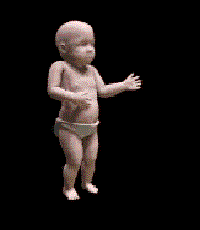
The Dancing Baby Read the article below from the New York Times in January of 1998 about the dancing baby and let me know what you think the meaning is. Give enough time for the baby to load onto the screen above. January 26, 1998 Enter Geekdom's Diaper Dandy. Sigmund, Can You Explain This? By DAVID BARBOZA - Copyright The New York Times He's no bigger than a computer screen, and no more than 2 years old, judging by appearances. His features are minimal, his hair even more so, and it is not even completely clear that he's a he. But the precocious, boogaloo dancing antics of a creature who is now universally known as the Dancing Baby are all the rage on the Internet. For two years, the 10-second video clip of the infant with the smooth moves has been fowarded from one computer to another, turned into a screen saver, and otherwise mesmerized growing numbers of computer users. The little diapered dynamo, the three-dimensional animated creation of software designers in California, has already become one of the first virtual characters to make the leap from the World Wide Web to prime time television. His big break came a few weeks ago, when "Ally McBeal," the popular Fox television show, featured the Dancing Baby in a segment that posed him as a hallucinatory reminder to McBeal that her biological clock was tick tick ticking away. Since then, the Dancing Baby has vaulted into the national consciousness as the newest, and youngest, pop icon. "Our Web bulletin board has exploded with talk of the baby," said Jeffrey Kramer, an executive producer of "Ally McBeal." "I think this is the first time the Internet -- which is a baby itself -- has influenced the larger medium." Already there is talk about a Dancing Baby doll, endorsements and even a television show. Of course, no one knows why this free-spirited, perversely sexy, footloose infant is poised to become the pet rock of his time, but, inevitably, greater significance is being attached to the phenomenon. Some believe the Dancing Baby (aka Baby Cha Cha) offers telling signs, not only about the future of technology but about deeper aspects of American culture and the human psyche. On request, Camille Paglia, the enfant terrible of academia, weighed in with a commentary on how fascination with the baby is really a sign of how infantile American youth have become. "For people to identify with a dancing baby indicates some deep deep trauma," she said in a telephone interview. "Young people want caretaking. They want someone to make rules, to monitor their sex life; they want daddies. The Dancing Baby is a self-portrait of American youth." What would Freud have made of the appeal of a diapered cyberkid with provocative gyrations? "Clearly this has an appeal," said Maryam Razavi, a professor at the New York School for Psychoanalytic, Psychotherapy and Psychoanalysis, navigating her computer and clicking her mouse on the baby's tummy to see it dance. "The baby clicks into something in our unconscious. A Freudian would see this as a person's wish to exhibit, to exhibit your freedom and your sexuality." The Dancing Baby was actually born about two years ago, by animators working for Kinetix, a software publisher in San Francisco, which said at least three animators designed the baby as a demo for an animation program. Michael Girard, an animator at Kinetix, a unit of Autodesk Inc., said designers superimposed the baby's image over the digital skeleton of an adult -- thus the adult-like movements. The dance was enhanced by another animator and that version was released into cyberspace sometime in mid-1996. "It was passed from geek to geek," says Lev Grossman, a producer at Pathfinder, the Web site owned by Time Inc. "It was an amazingly good piece of animation." Because the video dance clip could be easily altered, it spawned a generation of Baby Cha Cha permutations. There was Psycho Baby, Rasta Baby, Car Crash Baby and even Drunken Baby, which shows the corrupted digital infant smoking, drinking beer and urinating. There was even a version called Madonna Baby, which purported to be a digital clone of the pop singer's real child, which she had vowed to keep out of the public eye. And its dance motions, which include stroking an air guitar and dipping its head, were said to be imitations of one of Madonna's early pop incarnations -- another appealing Internet legend without foundation. But even if Madonna wasn't the inspiration, the baby still inspires. "The thing about the Internet is you find something and you can pass it around to 50 of your friends in no time," said Janelle Brown, a reporter at Wired News.